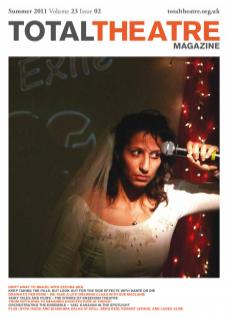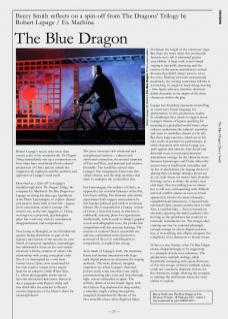Robert Lepage’s return after more than twenty years to his seminal work The Dragons’ Trilogy immediately sets up a commentary on how times have transformed both cultural projections of China and art (which the original work explored) and the aesthetic and approach of Lepage’s work itself.
Described as a ‘spin off’ to Lepage’s breakthrough show The Dragons’ Trilogy, his company Ex Machina’s The Blue Dragon sees Lepage revisiting his alter ego, Québécois artist Pierre Lamontagne, to explore themes pertinent to them both in later life – legacy, cross-culturalism, creative courage. He returns too, as the title suggests, to China, no longer as a projected, psychological place but a real one, with its concomitant disappointments and compromises.
Now living in Shanghai, in an old industrial quarter facing demolition as part of the regime’s reinvention of the area for its own brand of consumer capitalism, Lamontagne has substituted a focus on his own artistic creativity with the curation of others. His relationship with young conceptual artist Xiao Li is interrupted by a visit from former lover, Claire, now concerned for her own creative output in her urgent hunt for an adoptive child. When Xiao Li, whose photographic works mirror her own emotional elusiveness, discovers she is pregnant with Pierre’s child, will this child offer the solution to Pierre’s creative impotence or for Claire’s thirst for meaningfulness?
The piece excavates rich emotional and metaphorical territory – cultural and emotional connection, the mutual suspicion of East and West, and personal and creative fecundity. The world has turned since Lepage’s first imaginative forays into this subject matter, and the deep anxieties that seem to underpin the work reflect this.
For Lamontagne, the realities of China, as opposed to his youthful fantasies of the 80s, have been stifling. His domestic and artistic experiences both suggest emasculation by this harsher political and ruthless economic climate. He is suspended in a fantasy version of China, a historical house in which he is stubbornly resisting plans for regeneration. Aesthetically, with its nods to Herge’s graphic novels and calligraphic texts, the production sympathises with his atavistic leanings. The censure of modern China’s inexorable rise and rise, represented in the destructive portrayal of Xiao Li’s unwillingness to compromise, is implicit but strong.
As in much of Lepage’s work, the cinematic frame and human interaction with large-scale digital projections dominate the staging aesthetic. The more abstract, imagistic sequences are where Lepage’s theatrical powers really come into their own, richly communicating idea, tone and story through light, colour and bodies in space. The military dance of a lone female figure with the Chinese flag shadowed in deep scarlet; a romantic couple cycling through the imagined (remembered?) flurries of the first snowfall whose white digitised flakes illuminate the height of the enormous stage. But there are times when this profoundly humane story felt it warranted greater accessibility. A large-scale screen-based staging is inevitably alienating and the remove of the action maintained a critical distance that didn’t always seem to serve the story. Dealing with such monumental machinery, the writing sometimes felt like it was hefting its weight to keep things moving – time lapses and easy narrative shortcuts didn’t do justice to the depth of the three characters within the play.
Lepage has described cinematic storytelling as a necessary future language for performance. In this production, bodies in a landscape have much to suggest about Lepage’s themes of figures questing for meaning in a globalised world where other cultures undermine the subjects’ centrality and seem to symbolise threats to the self. But these huge canvases, which act in his solo works as partners in performance, as other characters with whom Lepage can push against and interact, here dwarf and diminish more conventional dramatic interactions onstage. In the climactic scene between Lamontagne and Claire (when she accuses him of intellectual cowardice and he her of alcoholism), the staging device of placing their exchange during a power cut in a to-scale house set metres back from the forestage serves to dilute the scene’s own electricity. The storytelling has no choice but to roll over, relinquishing such difficult and real conflict almost as soon as it had appeared in favour of a more schematic, straightforward interaction. A miraculously reformed Claire returns months later to find Xaio Li and her baby – Xaio Li herself an alcoholic, ignoring the baby’s pathetic cries for help as she prostitutes her creativity to ironically reproductive art. The images she’s copying out may be conjured pleasingly enough onstage by clever digital canvases but, as storytelling, this ellipsis cheapens the complexity of its characters to binary forms.
If this is a new theatre, what The Blue Dragon seems, disappointingly, to be suggesting is a triumph of style over substance. The production’s multiple endings, while theatrically intriguing and a great showcase of this tiny troupe of three’s multiple talents, evade any conclusive dramatic closure for the characters, simply allowing the company to sidestep the real human issues the story claims to explore.
Beccy Smith saw The Blue Dragon at The Barbican Theatre, 18 February 2011, where it was presented as part of BITE 2011.

